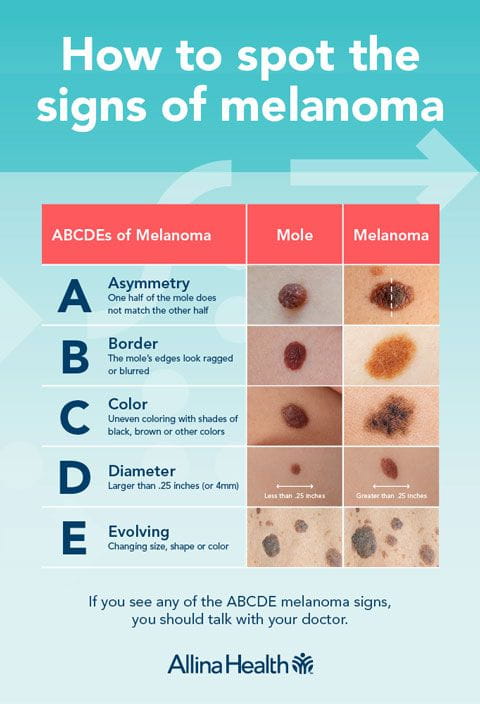
CARE
Know your moles and the ABCDE of melanoma
Posted April 25, 2025
- Melanoma is the deadliest form of skin cancer.
- The ABCDE rule is a guide to identify signs of melanoma.
- An estimated 70 percent of melanomas start as a brand new lesion, not in an existing mole.
Moles are normal collections of melanocytes (the pigment cells of our skin). They are not cancer. However, if the melanocytes become damaged, they can turn into melanoma, the deadliest form of skin cancer. The good news is when melanoma skin cancer is caught early, it is treatable. The best way to make sure your skin is healthy is to perform self-exams and get to know your moles through ABCDE, an acronym for signs of melanoma.
ABCDE signs of melanoma
[click on image to view larger]
- Asymmetry – The shape of one half of the mole looks different than the other half
- Border – The borders or edge of the mole look ragged or blurred
- Color – The mole has uneven coloring, with shades of black, brown, gray or other colors.
- Diameter – The size of the mole is greater than 4 mm or ¼ inch
- Evolving – The mole is changes in size, shape, color, or there's a new mole.
What percentage of moles are cancerous?
A recent review of published research on melanoma skin cancer has confirmed what many skin doctors and cancer specialists already knew: Most melanomas (an estimated 70%) start as a brand-new lesion, not in an existing mole, which is why it is especially important to pay attention to new moles.
That means you really need to know your skin. All adults should get in the habit of doing a monthly skin check, so they know where their moles are and what looks normal. That makes it much easier to notice a new or changing mole.
How do you perform a skin self-exam?
Most providers recommend a regular self-exam looking for new moles, but there are no guidelines from any accredited medical organizations detailing a specific cadence or period. With that in mind, consider doing self-exams monthly. Here’s how to do them:
- Choose a well-lit room.
- Use a full-length mirror, if possible, and a handheld mirror to help you view areas that are hard to see.
- Systematically, look at your body from head to toe, checking all areas.
- Make a mental note of lesions/moles, assessing them based on ABCDE.
- Write down what you observe and take pictures to make sure you have accurate information to compare in future self-exams.
When is a mole concerning?
Most of the time, moles are merely harmless clusters of pigmented cells. Normal moles are round or oval, with a smooth edge, and usually within one-quarter inch (six millimeters) in diameter. If the mole is the same color and solid throughout, it should not be anything to worry about. Melanomas can vary a lot in how they look and detecting them at an early stage can be critical and greatly increase your chances for cure. Generally, it is a good idea to follow the ABCDE signs to identify melanoma. However, you may find only one or two of these signs, and some moles may not fit the ABCDE rules.
Signs of early melanoma
- Most melanomas are black or brown, but they can be almost any color: skin-colored, pink, red, purple, blue or white.
- When it comes to darker skin tones, melanoma is more common on the palm of the hand or the sole of the foot. It could also appear as a dark streak under a nail.
- Keep an eye on moles that have different shades of the same color or different colors.
- Be especially watchful for new moles.
Signs of advanced melanoma
- When the melanoma is more advanced, the texture of the mole looks different. the skin surface may look broken or scraped.
- Watch out for moles that change appearance, especially with redness, scaling, bleeding, or oozing.
- Bigger moles can be a bad sign. However, size is not definitive proof of cancer.
Melanoma risk factors
Melanoma does not discriminate; anyone can get it. But there are factors that could put you at a higher risk for developing this form of skin cancer. They include:
- personal or family history of melanoma
- fair skin
- blue eyes
- history of sunburns
- having a large number of moles (more than 50).
Ways to reduce your risk of melanoma
Reduce your risk of melanoma and other skin cancers by protecting your skin from the sun:
- Wear a broad spectrum (UVA/UVB) sunscreen every day
- Wear a hat, sunglasses and other sun-protective clothing
- Seek shade when outside between 10 a.m. and 4 p.m.
- Avoid tanning and tanning beds.
If you see any of the ABCDE signs, notice a new pigmented lesion (even if it doesn't have the characteristics described above) or a mole that's changed, you should talk with your doctor. Don't wait until your next annual physical to bring it up—make an appointment soon. The only way to be sure is to remove tissue and check it for cancer cells. If you do have a melanoma, a doctor can remove it before it has a chance to spread.
-
Learn more about melanoma on our cancer resource hub
Read now -
Cancer treatment options from Allina Health
Melanoma care -
Learn about our world-class cancer institute
Learn more
MORE ARTICLES LIKE THIS
Get fun, inspiring, provider-reviewed articles sent to your inbox.
Sign up for our email newsletter





